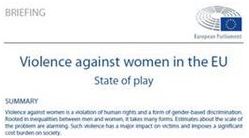Substance Use in Women
Извор: WUNRN – 06.02.2020

USA NIH – National Institute on Drug Abuse
https://www.drugabuse.gov/publications/drugfacts/substance-use-in-women
Women face unique issues when it comes to substance use, in part influenced by:
*Sex—differences based on biology
*Gender—differences based on culturally defined roles for men and women
Scientists who study substance use have discovered that women who use drugs can have issues related to hormones, menstrual cycle, fertility, pregnancy, breastfeeding, and menopause. In addition, women themselves describe unique reasons for using drugs, including controlling weight, fighting exhaustion, coping with pain, and attempts to self-treat mental health problems.
Science has also found that:
- Women often use substances differently than men, such as using smaller amounts of certain drugs for less time before they become addicted.
- Women can respond to substances differently. For example, they may have more drug cravings and may be more likely to relapse after treatment.
- Sex hormones can make women more sensitive than men to the effects of some drugs.
- Women who use drugs may also experience more physical effects on their heart and blood vessels.
- Brain changes in women who use drugs can be different from those in men.
- Women may be more likely to go to the emergency room or die from overdose or other effects of certain substances.
- Women who are victims of domestic violence are at increased risk of substance use.
- Divorce, loss of child custody, or the death of a partner or child can trigger women’s substance use or other mental health disorders.
- Women who use certain substances may be more likely to have panic attacks, anxiety, or depression.
Substance use while pregnant and breastfeeding
8.4 million females (or 6.6 percent) ages 18 and older have misused prescription drugs in the past year.1
The number of women with opioid use disorder at labor and delivery quadrupled from 1999-2014.3
Substance use during pregnancy can be risky to the woman’s health and that of her children in both the short and long term. Most drugs, including opioids and stimulants, could potentially harm an unborn baby. Use of some substances can increase the risk of miscarriage and can cause migraines, seizures, or high blood pressure in the mother, which may affect her fetus. In addition, the risk of stillbirth is 2 to 3 times greater in women who smoke tobacco or marijuana, take prescription pain relievers, or use illegal drugs during pregnancy.2 Surveys suggest that more women are using marijuana during pregnancy, which has health professionals concerned. The American College of Obstetrics and Gynecology (ACOG) suggests that marijuana can result in smaller babies, especially in women who use marijuana frequently in the first and second trimesters. ACOG recommends that pregnant women or women wanting to get pregnant should stop using marijuana, even if it is for medical purposes, and discuss options with their doctors that will be healthier for their babies.4 Pregnant women should check with their health care provider before using any medicines or substances.
When a woman uses some drugs regularly during pregnancy, the baby can go through withdrawal after birth, a condition called neonatal abstinence syndrome (NAS). Research has shown that NAS can occur with a pregnant woman’s use of opioids, alcohol, caffeine, and some prescription sedatives. The type and severity of a baby’s withdrawal symptoms depend on the drug(s) used, how long and how often the mother used, how her body breaks down the drug, and if the baby was born full-term or prematurely.
Photo by ©ThinkStock/George Doyle
Also, substance use by the pregnant mother can lead to long-term and even fatal effects, including:
- birth defects
- low birth weight
- premature birth
- small head size
- sudden infant death syndrome
Some substances, such as marijuana, alcohol, nicotine, and certain medicines, can be found in breast milk. However, little is known about the long-term effects on a child who is exposed to these substances through the mother’s milk. Scientists do know that teens who use drugs while their brains are still developing could be damaging their brain’s learning abilities. Therefore, similar risks for brain problems could exist for drug-exposed babies. Given the potential of all drugs to affect a baby’s developing brain, women who are breastfeeding should talk with a health care provider about all of their substance use.
Sex and gender differences in substance use disorder treatment
If a pregnant woman attempts to suddenly stop using drugs and alcohol without medical help, she can put her fetus at risk.
It is important to note that treatment for substance use disorders in women may progress differently than for men. Women report using some substances for a shorter period of time when they enter treatment. However, women’s substance use tends to progress more quickly from first use to addiction. Withdrawal may also be more intense for women. In some cases, women respond differently than men to certain treatments. For instance, nicotine replacement (patch or gum) does not work as well for women as for men.
It can be hard for any person with a substance use disorder to quit. But women in particular may be afraid to get help during or after pregnancy due to possible legal or social fears and lack of child care while in treatment. Women in treatment often need support for handling the burdens of work, home care, child care, and other family responsibilities.
Specific programs can help pregnant women safely stop drug use and also provide prenatal care. Certain types of treatment have shown positive results, especially if they provide services such as child care, parenting classes, and job training. Medications such as methadone and buprenorphine, combined with the treatments described above, can improve outcomes. Some babies will still need treatment for withdrawal symptoms. However, outcomes are better for the baby if the mother takes treatment medicine during pregnancy than if she continues to use opioids.
For more information about sex and gender issues for women related to substance use, read the Substance Use in Women Research Report.
The importance of including women in research
In the past, women were not included in most research because of the belief that women are more biologically complicated than men and that women were too busy caring for their children to participate in studies. However, excluding specific subgroups from research produces knowledge that only helps a portion of the public. Federal agencies, including the National Institutes of Health (NIH), have been instrumental in pushing for women to be included in clinical research. These efforts have ensured that broader public health issues related to sex and gender are studied.
Points to Remember
- Women face unique issues when it comes to substance use. These differences are influenced by sex (differences based on biology) and gender (differences based on culturally defined roles).
- Research has found many differences in how women and men use substances and react to substances. For example, women use drugs in smaller amounts than men, but they can experience the effects more strongly.
- Using substances while pregnant can harm the health of a pregnant woman and her fetus.
- More women are using marijuana during pregnancy than in past years, which could result in smaller babies and goes against the advice from the top medical group representing obstetricians.
- The use or misuse of some drugs while pregnant, especially opioids, can cause a newborn infant to experience withdrawal symptoms, a condition known as Neonatal Abstinence Syndrome (NAS).
- Substance use in women tends to develop into addiction more quickly than in men.
- It can be difficult for women to get help for a substance use problem during or after pregnancy because of social or legal fears. They may also lack child care while in treatment.
- Treatment programs should take these issues into consideration and offer child care, job training, and parenting classes.
- In the past, women were not included in clinical research. Federal agencies have made significant efforts to ensure that all subgroups of people are included and that issues related to sex and gender are being studied.



